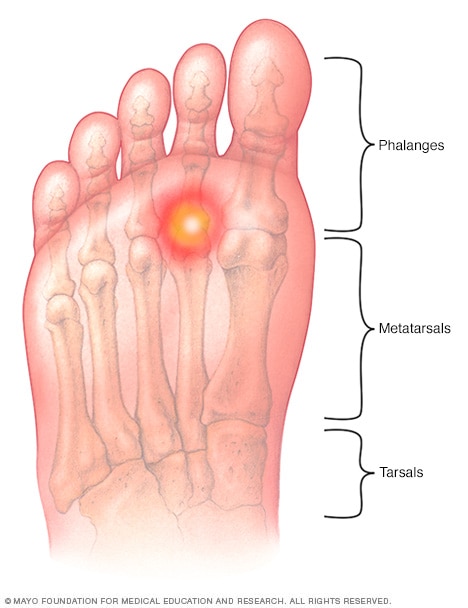Overview
Metatarsalgia (met-uh-tahr-SAL-juh) is a condition in which the ball of the foot becomes painful and irritated. Metatarsalgia results from activities that involve running and jumping. Other causes include feet that aren't formed correctly and shoes that are too tight or too loose.
Although not often serious, metatarsalgia can make it hard to move. At-home treatments, such as ice and rest, often relieve symptoms. Wearing proper footwear with shock-absorbing insoles or arch supports might prevent or lessen future problems with metatarsalgia.

Metatarsalgia
Too much pressure on the forefoot can cause pain and redness, called inflammation, in the long bones in the front of the feet, just below the toes, called metatarsals.
Symptoms
Symptoms of metatarsalgia can include:
- Sharp, aching or burning pain in the ball of the foot. The ball is the part of the sole just behind the toes.
- Pain that gets worse with standing, running, flexing the feet or walking. Doing any of these barefoot on a hard surface makes the pain worse. The pain gets better with rest.
- Sharp or shooting pain, numbness or tingling in the toes.
- A feeling of having a pebble in the shoe of the affected foot.
When to see a doctor
Not all foot problems need medical care. Sometimes feet ache after a long day of standing or a hard workout. But it's best to act on foot pain that lasts more than a few days. Talk to your health care professional if you have a burning pain in the ball of your foot that doesn't improve after changing your shoes and your activities.
From Mayo Clinic to your inbox
Causes
Sometimes a single factor can lead to metatarsalgia. More often, several factors are involved, including:
- Hard training or activity. Distance runners are at risk of metatarsalgia. This is mainly because the front of the foot takes in a lot of force when a person runs. But anyone who does a high-impact sport is at risk. This is especially true if shoes fit poorly or are worn down.
- Certain foot shapes. A high arch can put extra pressure on the metatarsals. So can having a second toe that's longer than the big toe. This causes more weight than usual to be shifted to the second metatarsal head.
- Toes that have different shapes. Wearing too-small shoes or high heels can cause feet and toes to change shape. A downward-curling toe, called a hammertoe, can cause metatarsalgia. So can swollen, painful bumps at the base of the big toes, called bunions.
- Excess weight. Most of a body's weight goes to the forefoot while moving. So extra pounds mean more pressure on the metatarsals. Losing weight might reduce or get rid of symptoms.
- High heels or poorly fitting shoes. High heels are a common cause of metatarsalgia. Wearing high heels puts extra weight on the front of the foot. Shoes with a narrow toe box or athletic shoes that don't have enough support and padding also can be part of the problem.
- Stress fractures. Small breaks in the metatarsals or toe bones can be painful and change the way you put weight on your foot.
- Morton's neuroma. This noncancerous growth of fibrous tissue around a nerve usually occurs between the third and fourth metatarsal heads. It causes symptoms that are like those of metatarsalgia. The growth can stress the metatarsal.
Risk factors
Almost anyone can develop metatarsalgia, but you're at higher risk if you:
- Do high-impact sports that involve running and jumping.
- Wear high heels, shoes that don't fit well or shoes with spikes, such as cleats.
- Are overweight or obese.
- Have other foot problems, including hammertoe and hard, thickened areas called calluses on the bottom of the feet.
- Have inflammatory arthritis, such as rheumatoid arthritis or gout.
Complications
Left untreated, metatarsalgia might lead to pain in other parts of the same foot or in the other foot. Limping because of the foot pain of metatarsalgia also can cause pain in other parts of the body, such as the low back or hip.